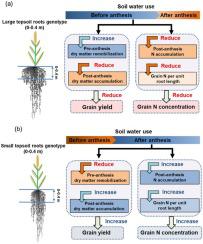European Journal of Agronomy ( IF 5.2 ) Pub Date : 2021-02-09 , DOI: 10.1016/j.eja.2021.126243 Yan Fang , Liyan Liang , Shuo Liu , Bingcheng Xu , Kadambot HM Siddique , Jairo A Palta , Yinglong Chen

|
Large distribution of roots in topsoil layers allow more uptake of soil water and nutrients during the vegetative growth, but it may be disadvantageous if soil water deficit develops during the reproductive stage. The relationship between the distribution of roots in topsoil (0–0.4 m) and soil water use, dry matter and nitrogen (N) accumulations, and grain yield was examined in winter wheat (Triticum aestivum L.) with contrasting root size in the topsoil. Two old landraces (CW134 and JM47, larger root length and biomass in the topsoil) and two modern wheat cultivars (CH58 and LH7, smaller root system size in the topsoil), were grown in the field during two seasons (2016–2017 and 2017–2018) under rainfed and irrigation conditions in the semi-arid farmland on the Loess Plateau. Root biomass and root length density (RLD) in topsoil (0–0.4 m) was significantly higher in the old landraces than in the modern cultivars (P < 0.05) under rainfed and irrigation in both seasons (no such difference in subsoil, 0.4–1.0 m). The modern cultivars had significantly higher grain yield, grain N concentration, water-use efficiency (WUE), and 1000-grain weight (P < 0.05). Seasonal water use was similar among all cultivars, but post-anthesis water use was higher in the modern cultivars, particularly under rainfed conditions in both seasons. Root biomass and RLD in the topsoil was positively correlated with pre-anthesis water use, but negatively correlated with after anthesis water use. Post-anthesis water use was closely related to post-anthesis dry matter, N accumulation, yield and WUE under rainfed conditions. To conclude, large distribution of roots in the topsoil had non-advantage for wheat grown under rainfed conditions. The small distribution of roots in the topsoil (characteristics of modern wheat cultivars) enhanced post-anthesis water use, increased post-anthesis dry matter and N accumulation, and hence attained higher grain yield and grain N when grown in the semi-arid environment.
中文翻译:

黄土高原半干旱地区表土根长短的小麦品种增加了花后水分利用和谷物产量
根系在表土层中的分布较大,可以在营养生长期间吸收更多的土壤水和养分,但是如果在繁殖阶段出现土壤缺水,则可能是不利的。研究了冬小麦(小麦)中表土(0–0.4 m)中根系的分布与土壤水分利用,干物质和氮(N)积累及籽粒产量之间的关系。L.)在表土中的根部大小相反。在两个季节(2016-2017年和2017年),在田间种植了两个古老的地方品种(CW134和JM47,表土中的根长和生物量较大)和两个现代小麦品种(CH58和LH7,表土中的根系较小)。 ––2018年)在黄土高原半干旱农田的雨水和灌溉条件下。在两个季节的雨水和灌溉条件下,旧地方种的表土(0–0.4 m)中的根生物量和根长密度(RLD)均显着高于现代品种(P <0.05)(地下无此差异,0.4–0.4)。 1.0 m)。现代品种的谷物产量,籽粒氮浓度,水分利用效率(WUE)和1000粒重(P<0.05)。所有品种的季节性用水量相似,但现代品种花后的用水量较高,特别是在两个季节均处于雨水条件下。表层土壤根系生物量和RLD与花前花水呈正相关,而与花后花水呈负相关。在雨育条件下,花后水分利用与花后干物质,氮素积累,产量和水分利用效率密切相关。总而言之,表土中根系的大量分布不利于在雨养条件下生长的小麦。在半干旱环境下种植时,表层土壤根系的分布很小(现代小麦品种的特征)提高了花后的水分利用,增加了花后的干物质和氮的积累,因此获得了更高的籽粒产量和籽粒氮。


























 京公网安备 11010802027423号
京公网安备 11010802027423号